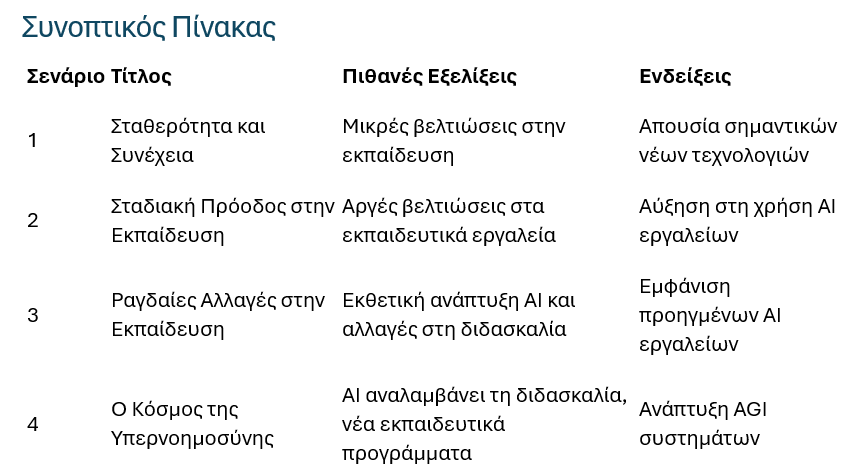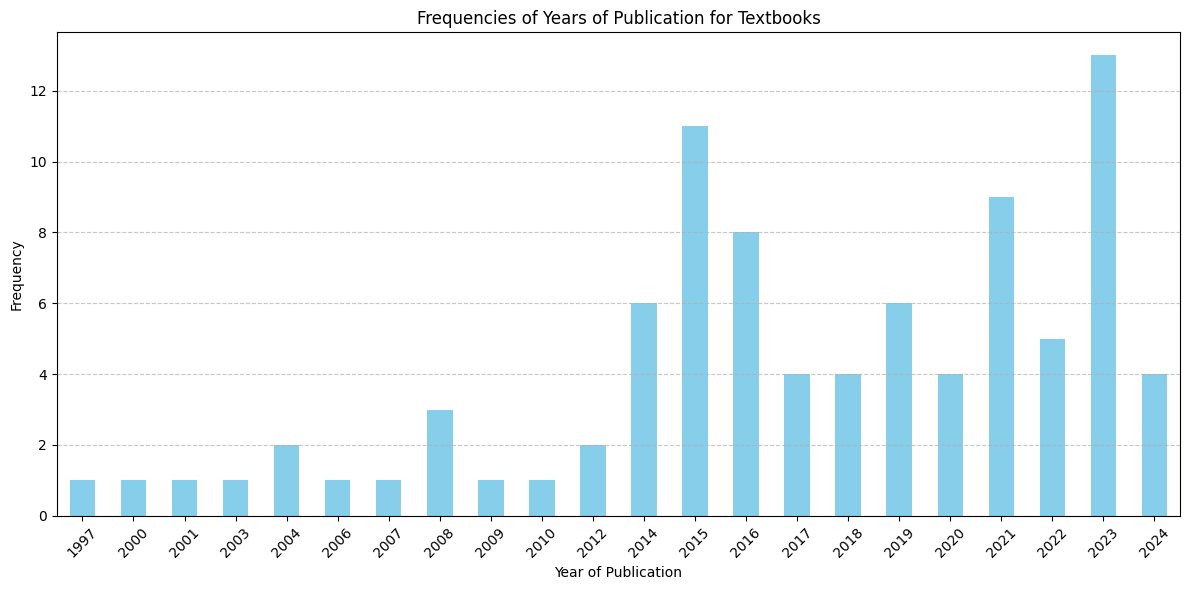Ο Four Futures Planner! Προετοιμάζοντας τους Εκπαιδευτικούς για το Μέλλον της Τεχνητής Νοημοσύνης13/7/2024 Φανταστήκατε ποτέ πώς θα είναι το μέλλον της εκπαίδευσης με την ταχύτατη εξέλιξη της τεχνητής νοημοσύνης;
Η προετοιμασία για το μέλλον χρησιμοποιώντας σενάρια επιτρέπει στους ανθρώπους να προβλέπουν και να προσαρμόζονται σε πιθανές αλλαγές, ελαχιστοποιώντας τους κινδύνους και εκμεταλλευόμενοι τις ευκαιρίες που μπορεί να προκύψουν. Ο "Four Futures Planner" (FFP) είναι μια προσαρμοσμένη εκδοχή του ChatGPT της OpenAI, βασισμένη στην αρχιτεκτονική GPT-4. Είναι προγραμματισμένος να βοηθά στη διεξαγωγή ασκήσεων στρατηγικού σχεδιασμού σχετικά με την τεχνητή νοημοσύνη (AI), χρησιμοποιώντας τις τεχνικές της εταιρείας Shell. Αυτό περιλαμβάνει τη δημιουργία σεναρίων με βάση τις δυνάμεις STEEP (Κοινωνικές, Τεχνολογικές, Οικονομικές, Περιβαλλοντικές και Πολιτικές), την ανάπτυξη πίνακα με τίτλους, βινιέτες και ενδείξεις για κάθε σενάριο. Στόχος του είναι να παρέχει σαφείς και χρήσιμες πληροφορίες για το πώς διαφορετικά σενάρια AI μπορούν να επηρεάσουν τη στρατηγική και τις αποφάσεις σε διάφορους τομείς, όπως η εκπαίδευση. Σε αυτό το σενάριο, πραγματοποιήσαμε μια άσκηση στρατηγικού σχεδιασμού για να εξετάσουμε πώς η τεχνητή νοημοσύνη (AI) μπορεί να επηρεάσει την καριέρα ενός δασκάλου/καθηγητή σε ένα σχολείο στην Ελλάδα. Ο FFP ανέπτυξε τέσσερα πιθανά σενάρια: 1) Όσο Καλό Γίνεται, 2) Βραδεία Ανάπτυξη, 3) Εκθετική Ανάπτυξη και 4) Τεχνητή Γενική Νοημοσύνη (Artificial General Intelligence, AGI). Κάθε σενάριο περιλαμβάνει τίτλο, πιθανές εξελίξεις και ενδείξεις, δίνοντας στους δασκάλους μια εικόνα για το πώς η AI θα μπορούσε να μεταμορφώσει τον εκπαιδευτικό τομέα και τον ρόλο τους μέσα σε αυτόν. Η χρήση του FFP μπορεί να είναι εξαιρετικά χρήσιμη για τους εκπαιδευτικούς, καθώς τους επιτρέπει να προετοιμαστούν για τις πιθανές μελλοντικές εξελίξεις στην τεχνητή νοημοσύνη και πώς αυτές μπορεί να επηρεάσουν το επάγγελμά τους. Συγκεκριμένα:
Με αυτές τις πληροφορίες, ένας εκπαιδευτικός μπορεί να είναι καλύτερα προετοιμασμένος και πιο αποτελεσματικός στη δουλειά του, ανεξάρτητα από τις τεχνολογικές εξελίξεις που μπορεί να προκύψουν. Ζητήσαμε από τον FFP να μας παρουσιάσει τις τέσσερις πιθανολογούμενες μελλοντικές εξελίξεις στην AI και πώς αυτές θα μπορούσαν να επηρεάσουν την καριέρα των δασκάλων/καθηγητών στα σχολεία. Ιδού το αποτέλεσμα: Σενάριο 1: Όσο Καλό Γίνεται Σε αυτό το σενάριο, η πρόοδος στην τεχνητή νοημοσύνη επιβραδύνεται σημαντικά. Η AI που χρησιμοποιούμε τώρα είναι η καλύτερη που θα έχουμε ποτέ. Τίτλος: Σταθερότητα και Συνέχεια Πιθανές Εξελίξεις:
Σενάριο 2: Βραδεία Ανάπτυξη Η AI συνεχίζει να αναπτύσσεται, αλλά με αργό ρυθμό. Η βελτίωση της AI είναι σταδιακή και προβλέψιμη. Τίτλος: Σταδιακή Πρόοδος στην Εκπαίδευση Πιθανές Εξελίξεις:
Σενάριο 3: Εκθετική Ανάπτυξη Η ανάπτυξη της AI επιταχύνεται εκθετικά, δημιουργώντας ραγδαίες αλλαγές. Τίτλος: Ραγδαίες Αλλαγές στην Εκπαίδευση Πιθανές Εξελίξεις:
Σενάριο 4: Γενική Τεχνητή Νοημοσύνη (AGI) Η τεχνητή νοημοσύνη φτάνει σε επίπεδα ισοδύναμα ή και ανώτερα από την ανθρώπινη νοημοσύνη. Τίτλος: Ο Κόσμος της Υπερνοημοσύνης Πιθανές Εξελίξεις:
Ανάλογα με το σενάριο που προκύπτει, οι εκπαιδευτικοί μπορεί να χρειαστεί να προσαρμόσουμε τη στρατηγική μας. Σε κάθε περίπτωση, η διαρκής εκπαίδευση και η προσαρμοστικότητα θα είναι κρίσιμες για το μέλλον μας. Η ολοκλήρωση μιας σχολικής εργασίας είναι πλέον θέμα λεπτών, ενώ μια πτυχιακή ή μεταπτυχιακή μπορεί να απαιτήσει μερικές ώρες ή μέρες. Μια διδακτορική διατριβή μπορεί να χρειαστεί περισσότερο – ίσως κάποιες εβδομάδες... Ένα νέο κύμα αλλαγών βρίσκεται μπροστά μας, οδηγούμενο από την άνοδο της Γενετικής Τεχνητής Νοημοσύνης (Generative AI). Αυτά τα ισχυρά εργαλεία, ικανά να παράγουν κείμενο, κώδικα και δεδομένα, διεισδύουν γρήγορα σε σχολεία και πανεπιστήμια, μεταμορφώνοντας τον τρόπο με τον οποίο οι μαθητές προσεγγίζουν τις σπουδές τους. Ωστόσο, ενώ η τεχνητή νοημοσύνη (TN) προσφέρει συναρπαστικές δυνατότητες για έρευνα, γραφή και μάθηση, εγείρει επίσης ανησυχίες σχετικά με την ακαδημαϊκή ακεραιότητα.
Αυτό το άρθρο δεν αφορά τη δαιμονοποίηση της ΤΝ ή την υποστήριξη της ανεξέλεγκτης χρήσης της. Πρόκειται για την αναγνώριση της πραγματικότητας: οι μαθητές χρησιμοποιούν ήδη εργαλεία ΤΝ. Τα σχολεία και τα πανεπιστήμια πρέπει να προσαρμοστούν. Πρέπει να εξοπλίσουμε τους μαθητές με τις γνώσεις και τις δεξιότητες για να πλοηγηθούν σε αυτό το νέο τοπίο, για να αξιοποιήσουμε τη δύναμη της ΤΝ για αποτελεσματική μάθηση και προετοιμασία σταδιοδρομίας. Ευθυγράμμιση Προγραμμάτων Σπουδών για την Ψηφιακή Εποχή Οι αναδυόμενες εκτιμήσεις υποδηλώνουν ότι ένα σημαντικό μέρος – δυνητικά έως και το 90% – των μελλοντικών θέσεων εργασίας θα απαιτήσει ισχυρές δεξιότητες ψηφιακής παιδείας. Αυτό απαιτεί μια κριτική επαναξιολόγηση του τρέχοντος εκπαιδευτικού τοπίου. Για να παραφράσουμε το τραγούδι του 1987 “Star Trekkin”, “Είναι δουλειά, Τζιμ, αλλά όχι όπως την ξέρουμε.” Ομοίως, τα σχολεία και πανεπιστήμια πρέπει να ξεκινήσουν μια αποστολή να εξοπλίσουν τους μαθητές/φοιτητές με τα απαραίτητα εργαλεία για ένα ταχέως μεταβαλλόμενο επαγγελματικό τοπίο. Υπάρχει ένα πιθανό παράδοξο μεταξύ των απαιτήσεων της βιομηχανίας και της έμφασης στην ακαδημαϊκή ακεραιότητα στην εκπαίδευση. Η επαγγελματική σφαίρα δίνει προτεραιότητα στην αποτελεσματικότητα και την παραγωγικότητα, αναζητώντας μεθόδους για να «εργαστείτε πιο έξυπνα, όχι πιο σκληρά» και να επιτύχετε υψηλότερα πρότυπα σε λιγότερο χρόνο. Αντίθετα, τα εκπαιδευτικά ιδρύματα παραδοσιακά δίνουν έμφαση στην ηθική συμπεριφορά και αποθαρρύνουν πρακτικές που θα μπορούσαν να θέσουν σε κίνδυνο την ακαδημαϊκή ακεραιότητα. Αυτό εγείρει ένα κρίσιμο ερώτημα: προετοιμάζουν οι τρέχουσες εκπαιδευτικές πρακτικές επαρκώς τους μαθητές να χρησιμοποιήσουν τα εργαλεία που θα συναντήσουν στη μελλοντική τους σταδιοδρομία; Αποκτούν οι μαθητές την απαραίτητη πρακτική εμπειρία με τις πιο πρόσφατες τεχνολογίες που επικρατούν στις σημερινές βιομηχανίες; Η ανησυχία είναι ότι τα εκπαιδευτικά ιδρύματα δεν ευθυγραμμίζουν αποτελεσματικά τα προγράμματα σπουδών με τη συνεχώς εξελισσόμενη αγορά εργασίας. Αυτή η αποσύνδεση θα μπορούσε να έχει ως αποτέλεσμα οι απόφοιτοι να μην έχουν την απαιτούμενη επάρκεια για την αντιμετώπιση των προκλήσεων του πραγματικού κόσμου. Ο εξοπλισμός των μαθητών με εργαλεία και γνώσεις που μπορεί να καταστούν παρωχημένες θα μπορούσε να τους καταστήσει απροετοίμαστους για ένα μέλλον όπου ορισμένοι ρόλοι εργασίας μπορεί να εξαφανιστούν εντελώς. Αντί να σταθούμε στις πιθανές βλάβες της ΤΝ στη διαδικασία μάθησης, μια πιο παραγωγική προσέγγιση θα ήταν να διερευνηθεί πώς αυτή η μετασχηματιστική τεχνολογία μπορεί να αξιοποιηθεί για να επιταχύνει την απόκτηση γνώσης και να ενισχύσει την ανθρώπινη ευημερία. – Θα αντικατασταθούν οι εργαζόμενοι από την τεχνητή νοημοσύνη; – Ναι, θα αντικατασταθούν από άλλους εργαζόμενοι που είναι ικανοί στη χρήση της τεχνητής νοημοσύνης. Το άρθρο στοχεύει να αποτελέσει έναν Δούρειο Ίππο. Ενημερώνοντας τους φοιτητές για τις τεράστιες δυνατότητες της ΤΝ για τις ακαδημαϊκές τους εργασίες σε όλα τα επίπεδα, ελπίζουμε να ωθήσουμε τα πανεπιστήμια στη δράση: ενημέρωση προγραμμάτων, εργασιών και αξιολογήσεων, ανάπτυξη σαφών πολιτικών χρήσης ΤΝ και, το πιο σημαντικό, προετοιμασία των σπουδαστών για το μέλλον που τους περιμένει με γνώμονα την ΤΝ. Βασικές Αρχές Ακολουθούν μερικές βασικές αρχές στις οποίες πρέπει να συμφωνήσουμε, πριν προχωρήσουμε. Πρέπει, λοιπόν,
- Έχω τη λύση, έχετε κάποιο πρόβλημα; Εργαλεία ΤΝ στην Εκπαίδευση Οι μαθητές μπορούν να χρησιμοποιήσουν εργαλεία ΤΝ για να βελτιώσουν την μαθησιακή τους εμπειρία σε διάφορα στάδια του εκπαιδευτικού τους ταξιδιού. Η ΤΝ μπορεί να είναι αποφασιστικής σημασίας για την προετοιμασία για ενδιάμεσες εξετάσεις και εργασίες, τη συμπύκνωση τεράστιων ποσοτήτων πληροφοριών σε εύπεπτες περιλήψεις, τη δημιουργία συναρπαστικών παρουσιάσεων, την ανάλυση δεδομένων, την οπτικοποίηση πολύπλοκων συνόλων δεδομένων και την εύρεση βασικών τάσεων. Η ΤΝ μπορεί επίσης να είναι συνεργάτης στη συγγραφή εργασιών. Δυσκολεύεστε να δομήσετε το δοκίμιό σας; Αφήστε ένα εργαλείο ΤΝ να συντάξει επιχειρήματα και να σκιαγραφήσει προσεγγίσεις ή να προτείνει λογικές μεταβάσεις μεταξύ παραγράφων. Αισθάνεστε χαμένοι κατά τη σύνταξη; Η ΤΝ μπορεί να αναλύσει το γραπτό σας, να βρει τομείς για βελτίωση και να προτείνει εναλλακτικές φράσεις ή δομές προτάσεων. Ενώ τα chatbots δεν πρέπει να γράφουν ολόκληρα δοκίμια ή εργαστηριακές αναφορές για εσάς (αυτό είναι λογοκλοπή!), μπορούν να είναι ισχυροί σύμμαχοι στη διαδικασία συγγραφής. Προτρέψτε τα chatbots με το θέμα σας και μπορούν να δημιουργήσουν ιδέες, να προτείνουν σχετικές πηγές και να συνοψίσουν βασικά ευρήματα από ερευνητικές εργασίες. Μπορούν να βοηθήσουν στη δομή του δοκιμίου σας περιγράφοντας επιχειρήματα και προτείνοντας συνδέσεις και μεταβάσεις. ατά τη σύνταξη, τα chatbots μπορούν να αναλύσουν τα γραπτά σας και να προτείνουν βελτιώσεις στη σαφήνεια και τη δομή των προτάσεων. Να θυμάστε βέβαια, πάντα να αξιολογείτε κριτικά τα αποτελέσματα του chatbot, να αναφέρετε οποιεσδήποτε πληροφορίες παρέχουν και να τα χρησιμοποιείτε ως εφαλτήριο για τη δική σας σκέψη και ανάλυση. Οι μαθητές μπορούν ακόμη και να μάθουν πώς να δημιουργούν bots που μπορούν να τους βοηθήσουν να κατανοήσουν οποιοδήποτε θέμα, να μάθουν μια γλώσσα, πώς να γράφουν κώδικα κ.λπ. Για οδηγίες βήμα προς βήμα πώς να δημιουργείτε bots σε 10 λεπτά, δείτε τη σχετική ενότητα στο δωρεάν ασύγχρονο διαδικτυακό μάθημα «Εργαλεία τεχνητής νοημοσύνης στην εκπαίδευση». Αποτελεσματικές Προτροπές Εάν αντιμετωπίζετε προβλήματα με τη σύνταξη της τέλειας προτροπής, απλώς δώστε την αρχική σας ιδέα στο chatbot και θα σας προτείνει μια πιο ξεκάθαρη και πιο εντυπωσιακή έκδοση. Στη συνέχεια, μπορείτε να επιλέξετε να αποδεχτείτε την πρόταση ή να βελτιώσετε την αρχική σας προτροπή. Για να το κάνετε αυτό, μπορείτε να χρησιμοποιήσετε μια προτροπή όπως αυτή: “Θα σου παράσχω μία πρόχειρη προτροπή. Πρότεινέ μου μια καλύτερη έκδοση και ρώτησέ με αν θέλω να τη χρησιμοποιήσω. Εδώ είναι η προτροπή […]”. Εάν το γλωσσικό μοντέλο δεν παράγει το επιθυμητό αποτέλεσμα, θυμηθείτε ότι είναι βοηθός σκέψης. Εξετάστε τις ακόλουθες πιθανότητες: 1. το αφεντικό δεν είναι τόσο νοήμον (μπορεί να μην έχετε εξηγήσει με σαφήνεια τι θέλετε), 2. το γλωσσικό μοντέλο δεν είναι τόσο νοήμον (ίσως δεν πληρώσατε αρκετά για να πάρετε έναν έξυπνο βοηθό, π.χ. το GPT-4), ή 3. και τα δύο. Υπάρχει μία ακόμη πιθανότητα. Το γλωσσικό μοντέλο δεν είναι έτοιμο να το κάνει αυτό – ΑΚΟΜΑ! Εάν δεν πιστεύετε ότι η ΤΝ δεν μπορεί να εκτελέσει μια συγκεκριμένη εργασία τώρα … απλά περιμένετε και θα δείτε! Αν δεν νομίζετε ότι η τεχνητή νοημοσύνη μπορεί να το κάνει [αυτό]… Κράτα την μπύρα μου ένα λεπτό! Διπλωματικές, Μεταπτυχιακές και Διατριβές Φανταστείτε να πρέπει να διαβάσετε ένα βουνό επιστημονικών άρθρων για την ερευνητική σας εργασία. Η ΤΝ μπορεί να αποτελέσει μια εξαιρετική βοηθό για την έρευνά σας. Αφήστε τη να διεξάγει σε βάθος βιβλιογραφικές ανασκοπήσεις, βρίσκοντας σχετικές πηγές και συνοψίζοντας τα βασικά ευρήματα. Κολλήσατε στο να διατυπώσετε μια συναρπαστική ερευνητική ερώτηση; Τα εργαλεία ΤΝ μπορούν να αναλύσουν την υπάρχουσα έρευνα και να προτείνουν ανεξερεύνητες οδούς ή αντεπιχειρήματα που θα μπορούσαν να οδηγήσουν σε πρωτοποριακές ανακαλύψεις. Η δύναμη της ΤΝ υπερβαίνει τη συλλογή πληροφοριών. Μπορεί να είναι η συνεργάτης σας στην ανάπτυξη μιας ισχυρής ακαδημαϊκής φωνής. Δυσκολεύεστε να δημιουργήσετε ένα συνεκτικό επιχείρημα στην εργασία σας; Η ΤΝ μπορεί να αναλύσει το γραπτό σας και να προτείνει τρόπους για να ενισχύσετε τη δήλωση της διατριβής σας και να διατυπώσετε λογικά τα επιχειρήματά σας. Χρειάζεται να αντιμετωπίσετε πιθανά αντεπιχειρήματα; Η ΤΝ μπορεί να σας βοηθήσει να εντοπίσετε πιθανές αδυναμίες στη συλλογιστική σας και να προτείνετε τρόπους για να τις αντιμετωπίσετε προληπτικά. Για τους προχωρημένους φοιτητές που ασχολούνται με τις εργασίες τους, η ΤΝ γίνεται ένα απαραίτητο εργαλείο. Φανταστείτε να αναλύετε βουνά δεδομένων. Τα εργαλεία ΤΝ μπορούν να οργανώσουν και να κατηγοριοποιήσουν πολύπλοκα σύνολα δεδομένων, επιτρέποντάς σας να προσδιορίσετε τάσεις και μοτίβα που μπορεί να παραλείψει το ανθρώπινο μάτι. Δυσκολεύεστε να διαμορφώσετε μια ισχυρή ερευνητική μεθοδολογία; Η ΤΝ μπορεί να σας βοηθήσει να εντοπίσετε σχετικές μεθόδους έρευνας και να προτείνει εργαλεία και τεχνικές προσαρμοσμένες στο συγκεκριμένο ερευνητικό σας ερώτημα. Αν και η ΤΝ δεν θα πρέπει να αντικαταστήσει τη δική σας έρευνα και κριτική σκέψη, μπορεί να είναι ένα ισχυρό εργαλείο για τον εξορθολογισμό και τη βελτίωση της διαδικασίας συγγραφής της διπλωματικής/μεταπτυχιακής εργασίας ή της διδακτορικής διατριβής σας. Ακολουθούν 10 προτροπές που μπορείτε να χρησιμοποιήσετε για να καθοδηγήσετε ένα chatbot για καθεμία από τις εργασίες και τις ενότητες του ερευνητικού έργου. 10 Προτροπές για Ερευνητικές Εργασίες 1. Επιλογή θεματικού πεδίου “Μπορείς να προτείνεις μερικά ενδιαφέροντα ερευνητικά θέματα που σχετίζονται με το [θέμα/πεδίο]; Ποια είναι μερικά νέα ζητήματα ή συζητήσεις που ανακύπτουν σε αυτόν τον τομέα;” 2. Διατύπωση ερευνητικής ερώτησης “Βασισμένοι στο θέμα [όνομα θέματος], μπορείς να με βοηθήσεις να διατυπώσω μια σαφή και κατευθυνόμενη ερευνητική ερώτηση; Πώς μπορώ να περιορίσω το πεδίο έρευνας για να γίνει πιο συγκεκριμένο;” 3. Ανασκόπηση βιβλιογραφίας “Μπορείς να συνοψίσεις τα βασικότερα ευρήματα από την υπάρχουσα βιβλιογραφία για το [ερώτημα/θέμα έρευνας]; Ποιες είναι μερικές σημαντικές μελέτες ή εργασίες που πρέπει να εξετάσω; Περίγραψε συνοπτικά τα βασικά ευρήματα και τα επιχειρήματα κάθε άρθρου, επισημαίνοντας πιθανά κενά στην τρέχουσα έρευνα.” 4. Ανάπτυξη υπόθεσης “Λαμβάνοντας υπόψη τη βιβλιογραφία για το [ερώτημα/θέμα έρευνας], εντόπισε 2-3 βασικές ερευνητικές ερωτήσεις που αντιμετωπίζουν τα κενά γνώσης που εντοπίστηκαν. Για κάθε ερευνητική ερώτηση, δημιούργησε μια αντίστοιχη υπόθεση που προτείνει μια πιθανή απάντηση ή λύση. Ποια πρόβλεψη μπορώ να κάνω με βάση τις προηγούμενες μελέτες;” 5. Σχεδιασμός μεθοδολογίας έρευνας “Ποιες είναι μερικές αποτελεσματικές μεθοδολογίες για την έρευνα του [ερευνητική ερώτηση/υπόθεση]; Πώς μπορώ να διασφαλίσω ότι οι μέθοδοι συλλογής δεδομένων μου είναι έγκυρες και αξιόπιστες;” 6. Συλλογή δεδομένων “Ποιες είναι μερικές κοινές μέθοδοι συλλογής δεδομένων για τη [μεθοδολογία έρευνας]; Πώς πρέπει να σχεδιάσω και να οργανώσω τη διαδικασία συλλογής δεδομένων μου για αυτή την εργασία; Περίγραψε ένα πιθανό χρονοδιάγραμμα έρευνας με βασικούς σταθμούς και προθεσμίες.” 7. Ανάλυση δεδομένων Περιγράψτε συνοπτικά τον τύπο των δεδομένων που συλλέξατε (π.χ. αριθμητικά δεδομένα, μεταγραφές συνεντεύξεων). “Μπορείς να με καθοδηγήσεις για το πώς να αναλύσω τα δεδομένα που συνέλεξα για την [ερευνητική ερώτηση/υπόθεση]; Ποια στατιστικά εργαλεία ή μεθόδους πρέπει να χρησιμοποιήσω για την ερμηνεία των δεδομένων; Πρότεινε κατάλληλες τεχνικές ανάλυσης δεδομένων.” Λάβετε υπόψη ότι ορισμένα συστήματα ΤΝ επιτρέπουν την μεταφόρτωση εικόνων των δεδομένων σας (π.χ. αρχεία excel) για περαιτέρω διαβούλευση με την ΤΝ. Αυτό το βήμα μπορεί να απαιτεί συγκεκριμένο λογισμικό. Συμβουλευτείτε τον επιβλέποντα σας. 8. Ερμηνεία αποτελεσμάτων “Πώς πρέπει να ερμηνεύσω τα αποτελέσματα της ανάλυσης των δεδομένων μου για την [ερευνητική ερώτηση/υπόθεση]; Κάνε μου μια επισκόπηση υψηλού επιπέδου των βασικών ευρημάτων και τάσεων που αποκαλύπτονται από τα δεδομένα. Τι υποδηλώνουν αυτά τα ευρήματα και πώς συγκρίνονται με τη βιβλιογραφία;” Επαναλαμβάνω ότι μπορείτε να ανεβάσετε εικόνες των αποτελεσμάτων (π.χ. SPSS output). Αυτό το βήμα μπορεί να απαιτεί συγκεκριμένο λογισμικό. Συμβουλευτείτε τον επιβλέποντα σας. 9. Εξαγωγή συμπερασμάτων. “Με βάση τα αποτελέσματα, δημιούργησε μια περίληψη των βασικών ευρημάτων. Ανάλυσε πώς συγκρίνονται αυτά τα ευρήματα με την υπάρχουσα βιβλιογραφία. Πρότεινε πιθανές εξηγήσεις για τα ευρήματα. Ποια συμπεράσματα μπορώ να βγάλω για [ερώτηση/υπόθεση έρευνας]; Προσδιόρισε πιθανούς περιορισμούς της έρευνας και πρότεινε τομείς για μελλοντική έρευνα με βάση τα ευρήματα. Δημιούργησε μια τελική παράγραφο που επαναλαμβάνει τη σημασία της έρευνας και τον πιθανό αντίκτυπό της στο πεδίο.” 10. Γράψτε και παρουσιάστε την έρευνά σας. “Βοήθησέ με να περιγράψω τη δομή της ερευνητικής μου έκθεσης σχετικά με [ερώτηση/υπόθεση έρευνας]; Ποια βασικά σημεία πρέπει να επισημάνω στην παρουσίασή μου και πώς μπορώ να προσελκύσω αποτελεσματικά το κοινό μου;” Εκτός από τα γνωστά chatbots (ChatGPT, Copilot, Gemini, Claude, Perplexity, Poe, You.com, κλπ.), υπάρχει μια πληθώρα εξειδικευμένων δωρεάν και επί πληρωμή εργαλείων ΤΝ (Quillbot, Elicit, Scite, Consensus, Humata, κλπ.) τα οποία μπορεί να σας βοηθήσουν σε κάθε ένα από τα στάδια της ερευνητικής διαδικασίας. Για μια επιμελημένη λίστα ανατρέξτε στο δωρεάν ασύγχρονο διαδικτυακό μάθημα «Εργαλεία τεχνητής νοημοσύνης στην εκπαίδευση». Συμπέρασμα Τα εργαλεία τεχνητής νοημοσύνης (ΤΝ) φέρνουν επανάσταση στον τρόπο με τον οποίο μαθαίνουμε, προσφέροντας μια πληθώρα δυνατοτήτων για την υποστήριξη των μαθητών σε διάφορες εργασίες. Η ραγδαία εξέλιξη της τεχνολογίας έχει ήδη επηρεάσει σημαντικά τον εκπαιδευτικό τομέα, φέρνοντας ριζικές αλλαγές στον τρόπο με τον οποίο διδάσκουμε και μαθαίνουμε. Ωστόσο, η πλήρης αξιοποίηση των δυνατοτήτων της ΤΝ προϋποθέτει την προσαρμογή του εκπαιδευτικού συστήματος. Είναι επιτακτική η ανάγκη εκσυγχρονισμού των εκπαιδευτικών προγραμμάτων, της μεθοδολογίας διδασκαλίας και της αξιολόγησης, ώστε να αντικατοπτρίζουν τις δυνατότητες και τα οφέλη που προσφέρει η ΤΝ. *** Ο Δρ Άγγελος Ροδαφηνός είναι Αναπληρωτής Καθηγητής στη μεθοδολογία έρευνας και εξ αποστάσεως εκπαίδευση στο Αριστοτέλειο Πανεπιστήμιο. Σπούδασε και εργάστηκε σε 13 πανεπιστήμια στην Αμερική, Αυστραλία, Κύπρο και Ελλάδα. Το συγγραφικό του έργο περιλαμβάνει τα βιβλία «Οι Ηλίθιοι είναι ανίκητοι: η μέθοδος Ro για την αντιμετώπισή τους και την αποτελεσματική επίλυση προβλημάτων», «Από πρίγκιπας βάτραχος και… τούμπαλιν: Πρακτικές ψυχολογικές τεχνικές, για να βελτιώσουμε τον εαυτό μας – ή τους άλλους», και «Λογική και… παραλογική! Κριτική σκέψη, ψυχολογία και επιστημονικός εγγραμματισμός», καθώς και την δημοσίευση 65 και πλέον επιστημονικών άρθρων σε διεθνή επιστημονικά περιοδικά. Εικόνες: Lexica Στην εποχή της ραγδαίας τεχνολογικής προόδου και της συνεχούς εξέλιξης της γνώσης, τα ελληνικά πανεπιστήμια αντιμετωπίζουν μια κρίσιμη πρόκληση: την απαρχαίωση των διδακτικών συγγραμμάτων. Μια πρόσφατη ανάλυση αποκάλυψε ότι σε ένα τυχαίο τομέα ενός πανεπιστημιακού τμήματος, τα βιβλία που χρησιμοποιούνται χρονολογούνται ακόμη και από το 1997 (βλ. Γράφημα 1). Σε αντίθεση, άλλα ιδρύματα παγκοσμίως έχουν ήδη υιοθετήσει σύγχρονα ebooks και εκπαιδευτικό υλικό δημιουργημένο από τεχνητή νοημοσύνη. Γράφημα 1: Χρονολογία Δημοσίευσης Συγγραμμάτων σε Τυχαίο Δείγμα Πανεπιστημιακού Τομέα. Αυτή η κατάσταση δεν είναι απλώς ένα ζήτημα παλαιότητας· αποτελεί σοβαρή απειλή για την ακαδημαϊκή αριστεία και την ανταγωνιστικότητα των φοιτητών μας. Τα ξεπερασμένα συγγράμματα βασίζονται συχνά σε βιβλιογραφία και δεδομένα των δεκαετιών του '80 και του '90, παρουσιάζοντας θεωρίες που ενδέχεται να έχουν αναθεωρηθεί ή καταρριφθεί. Αυτό όχι μόνο υπονομεύει την ποιότητα της εκπαίδευσης, αλλά θέτει τους φοιτητές σε μειονεκτική θέση στην παγκόσμια αγορά εργασίας και τον ακαδημαϊκό στίβο.
Η επικαιρότητα και η ακρίβεια της πληροφορίας είναι ζωτικής σημασίας. Οι φοιτητές πρέπει να έχουν πρόσβαση σε υλικό που αντανακλά τις τελευταίες εξελίξεις στην επιστήμη και την τεχνολογία. Τα σύγχρονα συγγράμματα δεν προσφέρουν απλώς ενημερωμένες γνώσεις· ενισχύουν την κριτική σκέψη, παρουσιάζοντας νέες προοπτικές και μεθοδολογίες που είναι απαραίτητες για την αντιμετώπιση των σύγχρονων προκλήσεων. Επιπλέον, η χρήση παρωχημένων βιβλίων θέτει σε κίνδυνο τη συμμόρφωση των ιδρυμάτων μας με τα διεθνή ακαδημαϊκά πρότυπα. Πολλοί κανονισμοί απαιτούν τη συνεχή ανανέωση των διδακτικών υλικών, και η αποτυχία συμμόρφωσης μπορεί να βλάψει σοβαρά την αξιοπιστία των προγραμμάτων σπουδών μας. Ένα ακόμη ανησυχητικό στοιχείο που αναδεικνύει την ανάγκη για αλλαγή είναι το γεγονός ότι η πλειοψηφία των συγγραμμάτων που χρησιμοποιούνται στα ελληνικά πανεπιστήμια φαίνεται να είναι γραμμένα από τους ίδιους τους διδάσκοντες των μαθημάτων. Αυτή η πρακτική, αν και μπορεί να φαίνεται βολική, εγείρει σοβαρά ερωτήματα σχετικά με την πολυφωνία και την ευρύτητα της ακαδημαϊκής γνώσης που παρέχεται στους φοιτητές. Η αποκλειστική χρήση βιβλίων γραμμένων από τους διδάσκοντες μπορεί να περιορίσει την έκθεση των φοιτητών σε διαφορετικές απόψεις και προσεγγίσεις, ενώ ταυτόχρονα δημιουργεί ένα κλειστό σύστημα που δυσχεραίνει την εισαγωγή νέων ιδεών και μεθοδολογιών από το ευρύτερο ακαδημαϊκό πεδίο. Επιπλέον, αυτή η τάση μπορεί να οδηγήσει σε στασιμότητα του εκπαιδευτικού υλικού, καθώς οι συγγραφείς-διδάσκοντες ενδέχεται να μην έχουν το χρόνο ή τα κίνητρα για συχνές αναθεωρήσεις και ενημερώσεις των βιβλίων τους, ιδιαίτερα όταν αυτά έχουν ήδη καθιερωθεί ως τα βασικά συγγράμματα των μαθημάτων τους. Η λύση είναι ξεκάθαρη αλλά απαιτεί άμεση δράση. Τα πανεπιστήμια πρέπει να επενδύσουν στην προμήθεια νέων, σύγχρονων συγγραμμάτων και να ξεκινήσουν τη σταδιακή αντικατάσταση των παλαιών. Αυτή η κίνηση δεν είναι απλώς μια αναβάθμιση· είναι μια επένδυση στο μέλλον των φοιτητών μας και στην ακαδημαϊκή υπεροχή των ιδρυμάτων μας. Καθώς ο κόσμος προχωρά με ιλιγγιώδεις ρυθμούς, δεν έχουμε την πολυτέλεια να μένουμε πίσω. Η αναβάθμιση των συγγραμμάτων δεν είναι απλώς μια επιλογή· είναι μια επιτακτική ανάγκη για τη διασφάλιση της ποιότητας της τριτοβάθμιας εκπαίδευσης στην Ελλάδα. Είναι καιρός να αναλάβουμε δράση και να εξοπλίσουμε τους φοιτητές μας με τα εργαλεία που χρειάζονται για να ανταγωνιστούν και να διαπρέψουν στον 21ο αιώνα. ------------------------------------------------------- *Ο Δρ Άγγελος Ροδαφηνός είναι Αναπληρωτής Καθηγητής στη μεθοδολογία έρευνας και εξ αποστάσεως εκπαίδευση στο Αριστοτέλειο Πανεπιστήμιο. Σπούδασε και εργάστηκε σε 13 πανεπιστήμια στην Αμερική, Αυστραλία, Κύπρο και Ελλάδα. Το συγγραφικό του έργο περιλαμβάνει τα βιβλία «Οι Ηλίθιοι είναι ανίκητοι», «Από πρίγκιπας βάτραχος και… τούμπαλιν», και «Λογική και… παραλογική!», καθώς και την δημοσίευση 65 και πλέον επιστημονικών άρθρων σε διεθνή επιστημονικά περιοδικά. Για το άρθρο αυτό συνεργάστηκε με το εργαλείο ΤΝ Claude. AI generated image: Lexica
Οι εκπαιδευτικοί μπορούν να αξιοποιήσουν τη δύναμη της Τεχνητής Νοημοσύνης (ΤΝ) για να εξορθολογήσουν τις καθημερινές τους λειτουργίες και να ενισχύσουν την παραγωγικότητα. Η τεχνολογία ΤΝ προσφέρει διάφορες εφαρμογές που μπορούν να βοηθήσουν τους εκπαιδευτικούς σε εργασίες όπως υπαγόρευση, διαχείριση email, παραγωγή μαθημάτων, αξιολόγηση, διασφάλιση ποιότητας, συγγραφή και επιμέλεια, έρευνα, οργάνωση συνεδρίων, ομιλίες, παρουσιάσεις, ακόμη και τη χρήση ρομπότ με τεχνητή νοημοσύνη. Ας εξερευνήσουμε κάθε κατηγορία με περισσότερες λεπτομέρειες. Υπαγόρευση
Παραγωγή μαθήματος
Αξιολόγηση
Διασφάλιση ποιότητας
Συγγραφή και επεξεργασία
Έρευνα
Οργάνωση Συνεδρίων
Ομιλίες και παρουσιάσεις
Bots
Αξιοποιώντας την τεχνολογία ΤΝ στις καθημερινές τους λειτουργίες, οι πανεπιστημιακοί μπορούν να βελτιώσουν την αποτελεσματικότητα, να εξορθολογήσουν τη ροή εργασίας και να εστιάσουν περισσότερο σε πολύτιμες δραστηριότητες έρευνας και διδασκαλίας. Είναι σημαντικό να σημειωθεί ότι ενώ η τεχνητή νοημοσύνη μπορεί να αυτοματοποιήσει ορισμένες εργασίες, η ανθρώπινη τεχνογνωσία των ακαδημαϊκών παραμένει ζωτικής σημασίας στην κριτική σκέψη, την ερμηνεία και τις διαδικασίες λήψης αποφάσεων. Εάν είστε εκπαιδευτικός και ενδιαφέρεστε να δείτε συγκεκριμένα εργαλεία και πρακτικές εφαρμογές, μπορείτε να επισκεφτείτε την ιστοσελίδα του δωρεάν διαδικτυακού μαθήματος https://payhip.com/b/cQmqN. *Ο Δρ Άγγελος Ροδαφηνός είναι Αναπληρωτής Καθηγητής στη μεθοδολογία έρευνας και εξ αποστάσεως εκπαίδευση στο Αριστοτέλειο Πανεπιστήμιο. Σπούδασε και εργάστηκε σε 13 πανεπιστήμια στην Αμερική, Αυστραλία, Κύπρο και Ελλάδα. Το συγγραφικό του έργο περιλαμβάνει τα βιβλία «Οι Ηλίθιοι είναι ανίκητοι», «Από πρίγκιπας βάτραχος και… τούμπαλιν», και «Λογική και… παραλογική!», καθώς και την δημοσίευση 65 και πλέον επιστημονικών άρθρων σε διεθνή επιστημονικά περιοδικά. Για το άρθρο αυτό συνεργάστηκε με το εργαλείο ΤΝ Gemini. Η ολοκλήρωση μιας σχολικής εργασίας είναι πλέον θέμα λεπτών, ενώ μια πτυχιακή ή μεταπτυχιακή μπορεί να απαιτήσει μερικές ώρες ή μέρες. Μια διδακτορική διατριβή μπορεί να χρειαστεί περισσότερο - ίσως κάποιες εβδομάδες! Εικόνα: Lexica
Ένα νέο κύμα αλλαγών βρίσκεται μπροστά μας, οδηγούμενο από την άνοδο της Γενετικής Τεχνητής Νοημοσύνης (Generative AI). Αυτά τα ισχυρά εργαλεία, ικανά να παράγουν κείμενο, κώδικα και δεδομένα, διεισδύουν γρήγορα σε σχολεία και πανεπιστήμια, μεταμορφώνοντας τον τρόπο με τον οποίο οι μαθητές προσεγγίζουν τις σπουδές τους. Ωστόσο, ενώ η τεχνητή νοημοσύνη (TN) προσφέρει συναρπαστικές δυνατότητες για έρευνα, γραφή και μάθηση, εγείρει επίσης ανησυχίες σχετικά με την ακαδημαϊκή ακεραιότητα. Αυτό το άρθρο δεν αφορά τη δαιμονοποίηση της ΤΝ ή την υποστήριξη της ανεξέλεγκτης χρήσης της. Πρόκειται για την αναγνώριση της πραγματικότητας: οι μαθητές χρησιμοποιούν ήδη εργαλεία ΤΝ. Τα σχολεία και τα πανεπιστήμια πρέπει να προσαρμοστούν. Πρέπει να εξοπλίσουμε τους μαθητές με τις γνώσεις και τις δεξιότητες για να πλοηγηθούν σε αυτό το νέο τοπίο, για να αξιοποιήσουμε τη δύναμη της ΤΝ για αποτελεσματική μάθηση και προετοιμασία σταδιοδρομίας. Ευθυγράμμιση Προγραμμάτων Σπουδών για την Ψηφιακή Εποχή Οι αναδυόμενες εκτιμήσεις υποδηλώνουν ότι ένα σημαντικό μέρος – δυνητικά έως και το 90% – των μελλοντικών θέσεων εργασίας θα απαιτήσει ισχυρές δεξιότητες ψηφιακής παιδείας. Αυτό απαιτεί μια κριτική επαναξιολόγηση του τρέχοντος εκπαιδευτικού τοπίου. Για να παραφράσουμε το τραγούδι του 1987 "Star Trekkin", "Είναι δουλειά, Τζιμ, αλλά όχι όπως την ξέρουμε." Ομοίως, τα σχολεία και πανεπιστήμια πρέπει να ξεκινήσουν μια αποστολή να εξοπλίσουν τους μαθητές/φοιτητές με τα απαραίτητα εργαλεία για ένα ταχέως μεταβαλλόμενο επαγγελματικό τοπίο. Υπάρχει ένα πιθανό παράδοξο μεταξύ των απαιτήσεων της βιομηχανίας και της έμφασης στην ακαδημαϊκή ακεραιότητα στην εκπαίδευση. Η επαγγελματική σφαίρα δίνει προτεραιότητα στην αποτελεσματικότητα και την παραγωγικότητα, αναζητώντας μεθόδους για να «εργαστείτε πιο έξυπνα, όχι πιο σκληρά» και να επιτύχετε υψηλότερα πρότυπα σε λιγότερο χρόνο. Αντίθετα, τα εκπαιδευτικά ιδρύματα παραδοσιακά δίνουν έμφαση στην ηθική συμπεριφορά και αποθαρρύνουν πρακτικές που θα μπορούσαν να θέσουν σε κίνδυνο την ακαδημαϊκή ακεραιότητα. Αυτό εγείρει ένα κρίσιμο ερώτημα: προετοιμάζουν οι τρέχουσες εκπαιδευτικές πρακτικές επαρκώς τους μαθητές να χρησιμοποιήσουν τα εργαλεία που θα συναντήσουν στη μελλοντική τους σταδιοδρομία; Αποκτούν οι μαθητές την απαραίτητη πρακτική εμπειρία με τις πιο πρόσφατες τεχνολογίες που επικρατούν στις σημερινές βιομηχανίες; Η ανησυχία είναι ότι τα εκπαιδευτικά ιδρύματα δεν ευθυγραμμίζουν αποτελεσματικά τα προγράμματα σπουδών με τη συνεχώς εξελισσόμενη αγορά εργασίας. Αυτή η αποσύνδεση θα μπορούσε να έχει ως αποτέλεσμα οι απόφοιτοι να μην έχουν την απαιτούμενη επάρκεια για την αντιμετώπιση των προκλήσεων του πραγματικού κόσμου. Ο εξοπλισμός των μαθητών με εργαλεία και γνώσεις που μπορεί να καταστούν παρωχημένες θα μπορούσε να τους καταστήσει απροετοίμαστους για ένα μέλλον όπου ορισμένοι ρόλοι εργασίας μπορεί να εξαφανιστούν εντελώς. Αντί να σταθούμε στις πιθανές βλάβες της ΤΝ στη διαδικασία μάθησης, μια πιο παραγωγική προσέγγιση θα ήταν να διερευνηθεί πώς αυτή η μετασχηματιστική τεχνολογία μπορεί να αξιοποιηθεί για να επιταχύνει την απόκτηση γνώσης και να ενισχύσει την ανθρώπινη ευημερία. - Θα αντικατασταθούν οι εργαζόμενοι από την τεχνητή νοημοσύνη; - Ναι, θα αντικατασταθούν από άλλους εργαζόμενοι που είναι ικανοί στη χρήση της τεχνητής νοημοσύνης. Το άρθρο στοχεύει να αποτελέσει έναν Δούρειο Ίππο. Ενημερώνοντας τους φοιτητές για τις τεράστιες δυνατότητες της ΤΝ για τις ακαδημαϊκές τους εργασίες σε όλα τα επίπεδα, ελπίζουμε να ωθήσουμε τα πανεπιστήμια στη δράση: ενημέρωση προγραμμάτων, εργασιών και αξιολογήσεων, ανάπτυξη σαφών πολιτικών χρήσης ΤΝ και, το πιο σημαντικό, προετοιμασία των σπουδαστών για το μέλλον που τους περιμένει με γνώμονα την ΤΝ. Βασικές Αρχές Ακολουθούν μερικές βασικές αρχές στις οποίες πρέπει να συμφωνήσουμε, πριν προχωρήσουμε. Πρέπει, λοιπόν, 1. Να αποδεχτούμε ότι η αλλαγή είναι η μόνη σταθερά. Ότι τα εργαλεία ΤΝ είναι εδώ και δεν πρόκειται να φύγουν σύντομα. 2. Να κατανοήσουμε ότι αν συνεχίσουμε να κάνουμε αυτό που κάναμε, θα συνεχίσουμε να παίρνουμε αυτό που παίρναμε. 3. Να εξετάσουμε τρόπους να εργαστούμε πιο έξυπνα, όχι πιο σκληρά. 4. Να μάθουμε πώς να χρησιμοποιούμε εργαλεία AI - διαφορετικά θα αντικατασταθούμε από άλλους που ξέρουν πώς να το κάνουν. 5. Να αφιερώσουμε χρόνο για να ακονίσουμε το τσεκούρι μας (ώστε να κόβει καλύτερα), και να κάνουμε τον εαυτό μας πιο πολύτιμο στην αγορά. 6. Να γίνουμε Ε.Ε.Π. (Επαγγελματίες Επιλυτές Προβλημάτων)! Να υιοθετήσουμε τη στάση: «Έχω τη λύση, έχετε κάποιο πρόβλημα;". Να συνειδητοποιήσουμε ότι για κάθε πρόβλημα, υπάρχει ένα εργαλείο AI που μπορεί να μας βοηθήσει να το λύσουμε. Έχω τη λύση, έχετε κάποιο πρόβλημα; Εργαλεία ΤΝ στην Εκπαίδευση Οι μαθητές μπορούν να χρησιμοποιήσουν εργαλεία ΤΝ για να βελτιώσουν την μαθησιακή τους εμπειρία σε διάφορα στάδια του εκπαιδευτικού τους ταξιδιού. Η ΤΝ μπορεί να είναι αποφασιστικής σημασίας για την προετοιμασία για ενδιάμεσες εξετάσεις και εργασίες, τη συμπύκνωση τεράστιων ποσοτήτων πληροφοριών σε εύπεπτες περιλήψεις, τη δημιουργία συναρπαστικών παρουσιάσεων, την ανάλυση δεδομένων, την οπτικοποίηση πολύπλοκων συνόλων δεδομένων και την εύρεση βασικών τάσεων. Η ΤΝ μπορεί επίσης να είναι συνεργάτης στη συγγραφή εργασιών. Δυσκολεύεστε να δομήσετε το δοκίμιό σας; Αφήστε ένα εργαλείο ΤΝ να συντάξει επιχειρήματα και να σκιαγραφήσει προσεγγίσεις ή να προτείνει λογικές μεταβάσεις μεταξύ παραγράφων. Αισθάνεστε χαμένοι κατά τη σύνταξη; Η ΤΝ μπορεί να αναλύσει το γραπτό σας, να βρει τομείς για βελτίωση και να προτείνει εναλλακτικές φράσεις ή δομές προτάσεων. Ενώ τα chatbots δεν πρέπει να γράφουν ολόκληρα δοκίμια ή εργαστηριακές αναφορές για εσάς (αυτό είναι λογοκλοπή!), μπορούν να είναι ισχυροί σύμμαχοι στη διαδικασία συγγραφής. Προτρέψτε τα chatbots με το θέμα σας και μπορούν να δημιουργήσουν ιδέες, να προτείνουν σχετικές πηγές και να συνοψίσουν βασικά ευρήματα από ερευνητικές εργασίες. Μπορούν να βοηθήσουν στη δομή του δοκιμίου σας περιγράφοντας επιχειρήματα και προτείνοντας συνδέσεις και μεταβάσεις. Κατά τη σύνταξη, τα chatbots μπορούν να αναλύσουν τα γραπτά σας και να προτείνουν βελτιώσεις στη σαφήνεια και τη δομή των προτάσεων. Να θυμάστε βέβαια, πάντα να αξιολογείτε κριτικά τα αποτελέσματα του chatbot, να αναφέρετε οποιεσδήποτε πληροφορίες παρέχουν και να τα χρησιμοποιείτε ως εφαλτήριο για τη δική σας σκέψη και ανάλυση. Οι μαθητές μπορούν ακόμη και να μάθουν πώς να δημιουργούν bots που μπορούν να τους βοηθήσουν να κατανοήσουν οποιοδήποτε θέμα, να μάθουν μια γλώσσα, πώς να γράφουν κώδικα κ.λπ. Για οδηγίες βήμα προς βήμα πώς να δημιουργείτε bots σε 10 λεπτά, δείτε τη σχετική ενότητα στο δωρεάν ασύγχρονο διαδικτυακό μάθημα «Εργαλεία τεχνητής νοημοσύνης στην εκπαίδευση». Αποτελεσματικές Προτροπές Εάν αντιμετωπίζετε προβλήματα με τη σύνταξη της τέλειας προτροπής, απλώς δώστε την αρχική σας ιδέα στο chatbot και θα σας προτείνει μια πιο ξεκάθαρη και πιο εντυπωσιακή έκδοση. Στη συνέχεια, μπορείτε να επιλέξετε να αποδεχτείτε την πρόταση ή να βελτιώσετε την αρχική σας προτροπή. Για να το κάνετε αυτό, μπορείτε να χρησιμοποιήσετε μια προτροπή όπως αυτή: "Θα σου παράσχω μία πρόχειρη προτροπή. Πρότεινέ μου μια καλύτερη έκδοση και ρώτησέ με αν θέλω να τη χρησιμοποιήσω. Εδώ είναι η προτροπή […]". Εάν το γλωσσικό μοντέλο δεν παράγει το επιθυμητό αποτέλεσμα, θυμηθείτε ότι είναι βοηθός σκέψης. Εξετάστε τις ακόλουθες πιθανότητες: 1. το αφεντικό δεν είναι τόσο νοήμον (μπορεί να μην έχετε εξηγήσει με σαφήνεια τι θέλετε), 2. το γλωσσικό μοντέλο δεν είναι τόσο νοήμον (ίσως δεν πληρώσατε αρκετά για να πάρετε έναν έξυπνο βοηθό, π.χ. το GPT-4), ή 3. και τα δύο. Υπάρχει μία ακόμη πιθανότητα. Το γλωσσικό μοντέλο δεν είναι έτοιμο να το κάνει αυτό - ΑΚΟΜΑ! Εάν δεν πιστεύετε ότι η ΤΝ δεν μπορεί να εκτελέσει μια συγκεκριμένη εργασία τώρα ... απλά περιμένετε και θα δείτε! Αν δεν νομίζετε ότι η τεχνητή νοημοσύνη μπορεί να το κάνει [αυτό]... Κράτα την μπύρα μου ένα λεπτό! Διπλωματικές, Μεταπτυχιακές και Διατριβές Φανταστείτε να πρέπει να διαβάσετε ένα βουνό επιστημονικών άρθρων για την ερευνητική σας εργασία. Η ΤΝ μπορεί να αποτελέσει μια εξαιρετική βοηθό για την έρευνά σας. Αφήστε τη να διεξάγει σε βάθος βιβλιογραφικές ανασκοπήσεις, βρίσκοντας σχετικές πηγές και συνοψίζοντας τα βασικά ευρήματα. Κολλήσατε στο να διατυπώσετε μια συναρπαστική ερευνητική ερώτηση; Τα εργαλεία ΤΝ μπορούν να αναλύσουν την υπάρχουσα έρευνα και να προτείνουν ανεξερεύνητες οδούς ή αντεπιχειρήματα που θα μπορούσαν να οδηγήσουν σε πρωτοποριακές ανακαλύψεις. Η δύναμη της ΤΝ υπερβαίνει τη συλλογή πληροφοριών. Μπορεί να είναι η συνεργάτης σας στην ανάπτυξη μιας ισχυρής ακαδημαϊκής φωνής. Δυσκολεύεστε να δημιουργήσετε ένα συνεκτικό επιχείρημα στην εργασία σας; Η ΤΝ μπορεί να αναλύσει το γραπτό σας και να προτείνει τρόπους για να ενισχύσετε τη δήλωση της διατριβής σας και να διατυπώσετε λογικά τα επιχειρήματά σας. Χρειάζεται να αντιμετωπίσετε πιθανά αντεπιχειρήματα; Η ΤΝ μπορεί να σας βοηθήσει να εντοπίσετε πιθανές αδυναμίες στη συλλογιστική σας και να προτείνετε τρόπους για να τις αντιμετωπίσετε προληπτικά. Για τους προχωρημένους φοιτητές που ασχολούνται με τις εργασίες τους, η ΤΝ γίνεται ένα απαραίτητο εργαλείο. Φανταστείτε να αναλύετε βουνά δεδομένων. Τα εργαλεία ΤΝ μπορούν να οργανώσουν και να κατηγοριοποιήσουν πολύπλοκα σύνολα δεδομένων, επιτρέποντάς σας να προσδιορίσετε τάσεις και μοτίβα που μπορεί να παραλείψει το ανθρώπινο μάτι. Δυσκολεύεστε να διαμορφώσετε μια ισχυρή ερευνητική μεθοδολογία; Η ΤΝ μπορεί να σας βοηθήσει να εντοπίσετε σχετικές μεθόδους έρευνας και να προτείνει εργαλεία και τεχνικές προσαρμοσμένες στο συγκεκριμένο ερευνητικό σας ερώτημα. Αν και η ΤΝ δεν θα πρέπει να αντικαταστήσει τη δική σας έρευνα και κριτική σκέψη, μπορεί να είναι ένα ισχυρό εργαλείο για τον εξορθολογισμό και τη βελτίωση της διαδικασίας συγγραφής της διπλωματικής/μεταπτυχιακής εργασίας ή της διδακτορικής διατριβής σας. Ακολουθούν 10 προτροπές που μπορείτε να χρησιμοποιήσετε για να καθοδηγήσετε ένα chatbot για καθεμία από τις εργασίες και τις ενότητες του ερευνητικού έργου. 10 Προτροπές για Ερευνητικές Εργασίες 1. Επιλογή θεματικού πεδίου "Μπορείς να προτείνεις μερικά ενδιαφέροντα ερευνητικά θέματα που σχετίζονται με το [θέμα/πεδίο]; Ποια είναι μερικά νέα ζητήματα ή συζητήσεις που ανακύπτουν σε αυτόν τον τομέα;" 2. Διατύπωση ερευνητικής ερώτησης "Βασισμένοι στο θέμα [όνομα θέματος], μπορείς να με βοηθήσεις να διατυπώσω μια σαφή και κατευθυνόμενη ερευνητική ερώτηση; Πώς μπορώ να περιορίσω το πεδίο έρευνας για να γίνει πιο συγκεκριμένο;" 3. Ανασκόπηση βιβλιογραφίας "Μπορείς να συνοψίσεις τα βασικότερα ευρήματα από την υπάρχουσα βιβλιογραφία για το [ερώτημα/θέμα έρευνας]; Ποιες είναι μερικές σημαντικές μελέτες ή εργασίες που πρέπει να εξετάσω; Περίγραψε συνοπτικά τα βασικά ευρήματα και τα επιχειρήματα κάθε άρθρου, επισημαίνοντας πιθανά κενά στην τρέχουσα έρευνα." 4. Ανάπτυξη υπόθεσης "Λαμβάνοντας υπόψη τη βιβλιογραφία για το [ερώτημα/θέμα έρευνας], εντόπισε 2-3 βασικές ερευνητικές ερωτήσεις που αντιμετωπίζουν τα κενά γνώσης που εντοπίστηκαν. Για κάθε ερευνητική ερώτηση, δημιούργησε μια αντίστοιχη υπόθεση που προτείνει μια πιθανή απάντηση ή λύση. Ποια πρόβλεψη μπορώ να κάνω με βάση τις προηγούμενες μελέτες;" 5. Σχεδιασμός μεθοδολογίας έρευνας "Ποιες είναι μερικές αποτελεσματικές μεθοδολογίες για την έρευνα του [ερευνητική ερώτηση/υπόθεση]; Πώς μπορώ να διασφαλίσω ότι οι μέθοδοι συλλογής δεδομένων μου είναι έγκυρες και αξιόπιστες;" 6. Συλλογή δεδομένων "Ποιες είναι μερικές κοινές μέθοδοι συλλογής δεδομένων για τη [μεθοδολογία έρευνας]; Πώς πρέπει να σχεδιάσω και να οργανώσω τη διαδικασία συλλογής δεδομένων μου για αυτή την εργασία; Περίγραψε ένα πιθανό χρονοδιάγραμμα έρευνας με βασικούς σταθμούς και προθεσμίες." 7. Ανάλυση δεδομένων Περιγράψτε συνοπτικά τον τύπο των δεδομένων που συλλέξατε (π.χ. αριθμητικά δεδομένα, μεταγραφές συνεντεύξεων). "Μπορείς να με καθοδηγήσεις για το πώς να αναλύσω τα δεδομένα που συνέλεξα για την [ερευνητική ερώτηση/υπόθεση]; Ποια στατιστικά εργαλεία ή μεθόδους πρέπει να χρησιμοποιήσω για την ερμηνεία των δεδομένων; Πρότεινε κατάλληλες τεχνικές ανάλυσης δεδομένων." Λάβετε υπόψη ότι ορισμένα συστήματα ΤΝ επιτρέπουν την μεταφόρτωση εικόνων των δεδομένων σας (π.χ. αρχεία excel) για περαιτέρω διαβούλευση με την ΤΝ. Αυτό το βήμα μπορεί να απαιτεί συγκεκριμένο λογισμικό. Συμβουλευτείτε τον επιβλέποντα σας. 8. Ερμηνεία αποτελεσμάτων "Πώς πρέπει να ερμηνεύσω τα αποτελέσματα της ανάλυσης των δεδομένων μου για την [ερευνητική ερώτηση/υπόθεση]; Κάνε μου μια επισκόπηση υψηλού επιπέδου των βασικών ευρημάτων και τάσεων που αποκαλύπτονται από τα δεδομένα. Τι υποδηλώνουν αυτά τα ευρήματα και πώς συγκρίνονται με τη βιβλιογραφία;" Επαναλαμβάνω ότι μπορείτε να ανεβάσετε εικόνες των αποτελεσμάτων (π.χ. SPSS output). Αυτό το βήμα μπορεί να απαιτεί συγκεκριμένο λογισμικό. Συμβουλευτείτε τον επιβλέποντα σας. 9. Εξαγωγή συμπερασμάτων. "Με βάση τα αποτελέσματα, δημιούργησε μια περίληψη των βασικών ευρημάτων. Ανάλυσε πώς συγκρίνονται αυτά τα ευρήματα με την υπάρχουσα βιβλιογραφία. Πρότεινε πιθανές εξηγήσεις για τα ευρήματα. Ποια συμπεράσματα μπορώ να βγάλω για [ερώτηση/υπόθεση έρευνας]; Προσδιόρισε πιθανούς περιορισμούς της έρευνας και πρότεινε τομείς για μελλοντική έρευνα με βάση τα ευρήματα. Δημιούργησε μια τελική παράγραφο που επαναλαμβάνει τη σημασία της έρευνας και τον πιθανό αντίκτυπό της στο πεδίο." 10. Γράψτε και παρουσιάστε την έρευνά σας. "Βοήθησέ με να περιγράψω τη δομή της ερευνητικής μου έκθεσης σχετικά με [ερώτηση/υπόθεση έρευνας]; Ποια βασικά σημεία πρέπει να επισημάνω στην παρουσίασή μου και πώς μπορώ να προσελκύσω αποτελεσματικά το κοινό μου;" Εκτός από τα γνωστά chatbots (ChatGPT, Copilot, Gemini, Claude, Perplexity, Poe, You.com, κλπ.), υπάρχει μια πληθώρα εξειδικευμένων δωρεάν και επί πληρωμή εργαλείων ΤΝ (Quillbot, Elicit, Scite, Consensus, Humata, κλπ.) τα οποία μπορεί να σας βοηθήσουν σε κάθε ένα από τα στάδια της ερευνητικής διαδικασίας. Για μια επιμελημένη λίστα ανατρέξτε στο δωρεάν ασύγχρονο διαδικτυακό μάθημα «Εργαλεία τεχνητής νοημοσύνης στην εκπαίδευση». Συμπέρασμα Τα εργαλεία τεχνητής νοημοσύνης (ΤΝ) φέρνουν επανάσταση στον τρόπο με τον οποίο μαθαίνουμε, προσφέροντας μια πληθώρα δυνατοτήτων για την υποστήριξη των μαθητών σε διάφορες εργασίες. Η ραγδαία εξέλιξη της τεχνολογίας έχει ήδη επηρεάσει σημαντικά τον εκπαιδευτικό τομέα, φέρνοντας ριζικές αλλαγές στον τρόπο με τον οποίο διδάσκουμε και μαθαίνουμε. Ωστόσο, η πλήρης αξιοποίηση των δυνατοτήτων της ΤΝ προϋποθέτει την προσαρμογή του εκπαιδευτικού συστήματος. Είναι επιτακτική η ανάγκη εκσυγχρονισμού των εκπαιδευτικών προγραμμάτων, της μεθοδολογίας διδασκαλίας και της αξιολόγησης, ώστε να αντικατοπτρίζουν τις δυνατότητες και τα οφέλη που προσφέρει η ΤΝ. *Ο Δρ Άγγελος Ροδαφηνός είναι Αναπληρωτής Καθηγητής στη μεθοδολογία έρευνας και εξ αποστάσεως εκπαίδευση στο Αριστοτέλειο Πανεπιστήμιο. Σπούδασε και εργάστηκε σε 13 πανεπιστήμια στην Αμερική, Αυστραλία, Κύπρο και Ελλάδα. Το συγγραφικό του έργο περιλαμβάνει τα βιβλία «Οι Ηλίθιοι είναι ανίκητοι: η μέθοδος Ro για την αντιμετώπισή τους και την αποτελεσματική επίλυση προβλημάτων», «Από πρίγκιπας βάτραχος και… τούμπαλιν: Πρακτικές ψυχολογικές τεχνικές, για να βελτιώσουμε τον εαυτό μας – ή τους άλλους», και «Λογική και… παραλογική! Κριτική σκέψη, ψυχολογία και επιστημονικός εγγραμματισμός», καθώς και την δημοσίευση 65 και πλέον επιστημονικών άρθρων σε διεθνή επιστημονικά περιοδικά. |
Dr Ro's blogShare your ideas for problem solving and dealing with idiots, or join the Idiots Club (a.k.a. Boneheads' Academy) in Facebook. Archives
July 2024
Categories |







 RSS Feed
RSS Feed

